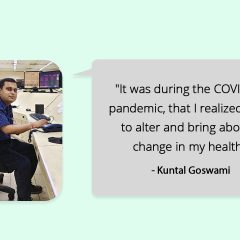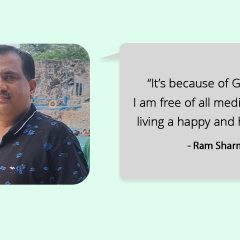
Ever since I have started health counselling, I have met at least 8 out of 10 people who go through a guilt factor after having eaten foods that they love the most.. Some of these people literally hate themselves for having done that. For most of these individuals an outing/ family occasion/weekend/holiday means more worry about weight and less enjoyment.
Some of them miss meeting their friends and have stopped living their life because they don’t want to indulge while they are out.
Are you one of them?
If you are then, you must know that worry puts you and your body through stress and stress releases a hormone called cortisol which in turn promotes fat storage in our body. It increases the heart rate and breathing too. All of this can make one sick.
Cortisol makes you depressed and creates an imbalance in the biochemical reactions of the body. If you are worried about your health and weight, you must also be aware of the connection between the body and your mind. Our emotions share biochemical links with our digestive, nervous, endocrine and the immune system.
You must keep your negative thoughts and guilt away, else it will add up to stress. Your body will not be able to digest the food when you are very stressed! It’s like trying to stop a bull when he gets out of control. It’s just a’int going to happen. Everyone has one weakness in food it could be a brownie, an ice cream cake, cheese cake, Pizzas, burgers and the likes that can make you go off track. For me it’s the brownie cake and oh yes how can I forget Pizzas! If one keeps feeling guilty about these foods one in a way then guilt is going to take the pleasure out of eating.
I would say eating without guilt is the key to keeping yourself healthy. It’s about enjoyment, spending time with family and at the same time having a balance in everything you do. One should not worry unless you know you are eating extra everyday.
You must remember that there are no bad foods, there are just poor habits.
If you can form good habits over a period of time, eventually you will build a healthier you and start eating in moderation without guilt.
Here are some tips to eat guilt free and keep yourself in shape:
* Eat a bowl of salad before heading for a dine out as it will add on to the fiber in take, so while you enjoy family favorite, fiber will help you keep full for longer time.
*Enjoy your favorite food, savor it, eat mindfully, slow eating will automatically lead to portion control.
*Hydrate your body cells well, the craving for junk might be just that your body is thirsty.
*Moderation is the key.
*Don’t forget to add greens along with your favorite food.
*One meal or one food doesn’t make you healthy or unhealthy, worry is less healthier.
* Emotions are important, try to build good connect with people around you and contribute to the society, that will help you keep yourself positive and increase your serotonin levels. (The feel good hormone), in a way you are doing good to yourself while doing good to others.
*Remember a workout is not about just going to gym, it’s about doing what you love, it can be dancing, chasing dog,washing car,gardening, cycling, have a life out of weight loss.
*Sleep well it will help restoring mind and body.
* Emotional eating due to stress is a part of life, try to reduce it by getting into hobbies, if you are finding it difficult to manage, relaxation techniques like breathing,meditation and yoga will help,feel good about yourself,live this moment, try to focus on present.
*Try adding food instead of subtracting and starving yourself, eating at regular interval helps your body boost metabolism.
*Slurp your juicy favorite fruits in the first half of the day when you are going to party out.
*Try switching from beer/diet sodas to wine.
*Go walking when the weather’s nice and you are looking pretty, enjoy the wind that shall make you move.
*Share your meals with your partner/friend so that you don’t stuff yourself.
*Don’t worry if you overeat a little, make sure of regular exercise and balancing out meals.
I would say shed off the guilt and move on!



